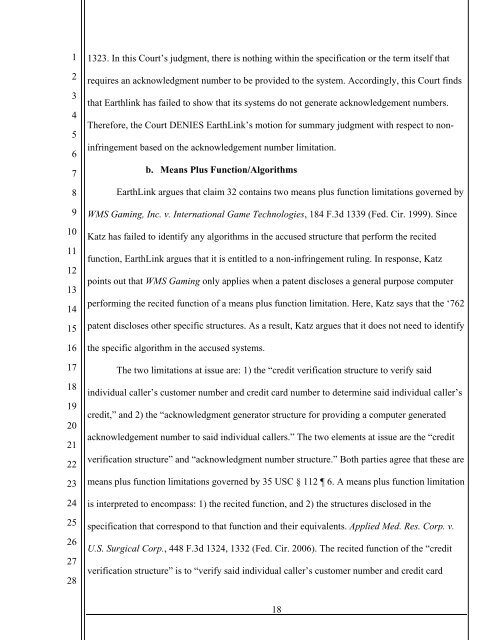Ronald A. Katz Technology Licensing v. Earthlink - IP Spotlight
Ronald A. Katz Technology Licensing v. Earthlink - IP Spotlight
Ronald A. Katz Technology Licensing v. Earthlink - IP Spotlight
You also want an ePaper? Increase the reach of your titles
YUMPU automatically turns print PDFs into web optimized ePapers that Google loves.
1<br />
2<br />
3<br />
4<br />
5<br />
6<br />
7<br />
8<br />
9<br />
10<br />
11<br />
12<br />
13<br />
14<br />
15<br />
16<br />
17<br />
18<br />
19<br />
20<br />
21<br />
22<br />
23<br />
24<br />
25<br />
26<br />
27<br />
28<br />
1323. In this Court’s judgment, there is nothing within the specification or the term itself that<br />
requires an acknowledgment number to be provided to the system. Accordingly, this Court finds<br />
that <strong>Earthlink</strong> has failed to show that its systems do not generate acknowledgement numbers.<br />
Therefore, the Court DENIES EarthLink’s motion for summary judgment with respect to noninfringement<br />
based on the acknowledgement number limitation.<br />
b. Means Plus Function/Algorithms<br />
EarthLink argues that claim 32 contains two means plus function limitations governed by<br />
WMS Gaming, Inc. v. International Game Technologies, 184 F.3d 1339 (Fed. Cir. 1999). Since<br />
<strong>Katz</strong> has failed to identify any algorithms in the accused structure that perform the recited<br />
function, EarthLink argues that it is entitled to a non-infringement ruling. In response, <strong>Katz</strong><br />
points out that WMS Gaming only applies when a patent discloses a general purpose computer<br />
performing the recited function of a means plus function limitation. Here, <strong>Katz</strong> says that the ‘762<br />
patent discloses other specific structures. As a result, <strong>Katz</strong> argues that it does not need to identify<br />
the specific algorithm in the accused systems.<br />
The two limitations at issue are: 1) the “credit verification structure to verify said<br />
individual caller’s customer number and credit card number to determine said individual caller’s<br />
credit,” and 2) the “acknowledgment generator structure for providing a computer generated<br />
acknowledgement number to said individual callers.” The two elements at issue are the “credit<br />
verification structure” and “acknowledgment number structure.” Both parties agree that these are<br />
means plus function limitations governed by 35 USC § 112 6. A means plus function limitation<br />
is interpreted to encompass: 1) the recited function, and 2) the structures disclosed in the<br />
specification that correspond to that function and their equivalents. Applied Med. Res. Corp. v.<br />
U.S. Surgical Corp., 448 F.3d 1324, 1332 (Fed. Cir. 2006). The recited function of the “credit<br />
verification structure” is to “verify said individual caller’s customer number and credit card<br />
18


